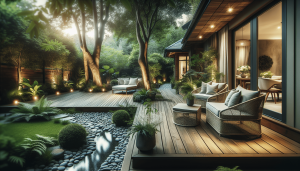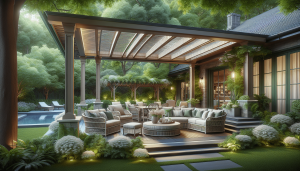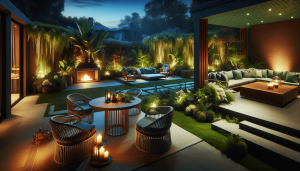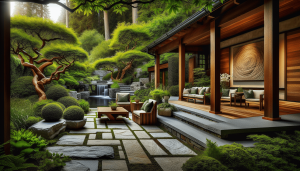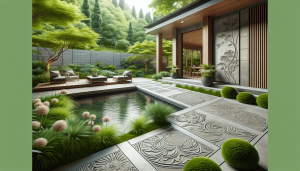Are you tired of tracking mud and dirt into your home? A mudroom can solve this problem. This guide will show you how to add a functional mudroom to your Copperas Cove, Harker Heights, or Killeen home. We’ll cover planning, design, costs, and installation options.
You’ll learn how to create a space that keeps your home clean and organized, all while staying within your budget. Whether you’re looking to improve your home’s value or simply make life easier, this guide has you covered.
Key Takeaways
- Adding a mudroom enhances organization, increases property value, and improves daily routines
- Proper planning and budgeting are crucial for a successful mudroom addition project
- Customize mudroom features to fit your family’s specific needs and lifestyle
- Incorporate energy-efficient elements to reduce costs and environmental impact in your mudroom
- Regular maintenance and prompt repairs help prolong the longevity of your mudroom
Understanding the Benefits of Adding a Mudroom to Your Home

Adding a mudroom to your home brings multiple benefits. You’ll enhance organization, increase property value, and improve daily routines. A mudroom protects our Google listing living spaces from dirt and clutter.
This cost-effective addition creates a functional space that can be as simple as a small room or as complex as a full bathroom. Proper joist support ensures a sturdy foundation for your new mudroom.
Enhancing Home Organization With a Mudroom
A mudroom serves as a central hub for organization, keeping your home tidy and clutter-free. You can maximize storage by installing custom cabinets, shelves, and hooks to accommodate coats, shoes, and backpacks.
This renovation project not only enhances your daily routine but also prevents dirt from spreading to other areas of your house, including the kitchen and basement.
Your mudroom can be designed to complement your home’s style, featuring durable flooring options that withstand heavy foot traffic. Consider adding a window to bring in natural light, making the space feel more inviting.
With proper planning, your mudroom can seamlessly integrate with adjacent rooms, creating a smooth transition from outdoors to indoors while maintaining a clean and organized living environment.
Increasing Property Value Through a Mudroom Addition
Adding a mudroom to your home can significantly increase its value. This practical home improvement project not only enhances functionality but also appeals to potential buyers.
You’ll find that a well-designed mudroom can set your property apart in the real estate market, especially if it includes features like built-in storage or a connection to your bedroom or attic.
When planning your mudroom addition, consider how it integrates with your existing home structure. A thoughtfully constructed wall between the mudroom and main living areas can improve energy efficiency and create a clear transition space. Even in a mobile home, you can incorporate a compact mudroom design that maximizes space and adds value to your property.
Improving Daily Routines and Family Convenience
A mudroom streamlines your daily routines by providing a designated space for family members to store and retrieve essential items. You can work with a general contractor to design custom cabinetry that accommodates each person’s needs, from shoe storage to coat hooks.
This organized approach saves time and reduces stress during busy mornings or when returning home.
Your mudroom’s interior design can incorporate elements that support your family’s lifestyle. Consider consulting an architect to create a layout that includes a small workspace for sorting mail or a charging station for devices.
By integrating these functional elements into your garage or entryway, you’ll create a more efficient and convenient living space for everyone in your household.
Protecting Living Spaces From Dirt and Clutter
Your mudroom acts as a barrier against dirt and clutter entering your main living spaces. By installing durable flooring and adding a bench near the entrance, you create a designated area for removing shoes and outdoor gear.
This setup prevents tracking mud and debris into your home, keeping your laundry room and other areas cleaner.
Consider incorporating a small sink or washbasin in your mudroom design, similar to what you might find in a porch or sunroom. This feature allows for quick clean-ups before entering the main house.
Work with an electrician to ensure proper lighting and outlets for added functionality, including a space to dry wet items or charge devices. A well-planned mudroom with a high ceiling can also serve as a transition area between your garage and interior spaces.
Planning Your Mudroom Addition

Planning your mudroom addition involves key steps to ensure success. You’ll need to assess available space, choose between remodeling or new construction, navigate building codes, and set a realistic budget.
Consider factors like waterproofing, sink installation, and drywall work. By carefully planning each aspect, you’ll create a functional mudroom that meets your needs and complies with local regulations.
Assessing Available Space and Ideal Location
When planning your mudroom addition, carefully assess your available space to determine the ideal location. You might consider converting an existing closet or pantry near your home’s entrance, or repurposing a portion of your garage for this purpose.
If you have a concrete slab foundation, you can build directly on it, potentially increasing your return on investment by utilizing existing structures.
Think about the utility of your chosen location. A mudroom near your kitchen can double as a pantry storage area, while one adjacent to your laundry room can streamline your cleaning routine. If you’re short on interior space, consider building a small addition off your main entrance, ensuring it complements your home’s exterior and provides the functionality you need.
Choosing Between Remodeling or New Construction
When deciding between remodeling or new construction for your mudroom, consider your home’s existing structure and foundation. Remodeling an existing space, like a portion of your garage, can be a cost-effective option that maximizes your investment.
You’ll need to assess the condition of the current flooring, walls, and siding to determine if they can support the new mudroom features.
New construction allows you more freedom in design but requires a larger initial investment. You’ll need to pour a new foundation and ensure proper integration with your home’s existing structure.
This option gives you the flexibility to add features like a shower or custom storage solutions. Remember to factor in costs for paint, flooring, and any necessary exterior work to match your home’s siding.
Navigating Building Codes and Permits
Before starting your mudroom project, you must navigate local building codes and obtain necessary permits. Check with your city’s building department to understand regulations for square footage, primary entrance modifications, and any bathroom addition plans.
Ensure your design complies with zoning laws and safety standards, particularly if you’re altering the home’s exterior or adding electrical outlets.
Work with a licensed contractor who understands local requirements for countertop installations and structural changes. They can help you create a design that meets code while maximizing functionality. Remember, proper permitting protects your investment and ensures your mudroom addition is safe and legal:
| Permit Type | Typical Requirements | Estimated Processing Time |
|---|---|---|
| Building Permit | Detailed plans, structural calculations | 2-4 weeks |
| Electrical Permit | Wiring diagram, load calculations | 1-2 weeks |
| Plumbing Permit | Pipe layout, fixture details | 1-2 weeks |
Setting a Realistic Budget for the Project
To set a realistic budget for your mudroom project, start by itemizing costs for each element, including materials for shelves, drawers, and flooring. Factor in labor costs for tasks like framing, drywall installation, and any necessary deck modifications.
Don’t forget to allocate funds for building permits and potential zoning fees, which can vary depending on your location and project scope.
Consider setting aside 10-15% of your total budget for unexpected expenses, such as addressing building code issues or structural challenges. This buffer will help you avoid financial stress if you encounter surprises during construction.
Remember to prioritize essential elements like durable flooring and functional storage, which will provide the most value for your investment.
Designing a Functional Mudroom Layout

Design your mudroom layout to maximize efficiency and functionality. You’ll need to select durable materials that withstand heavy foot traffic and incorporate smart storage solutions. Optimize lighting and ventilation to create a welcoming space.
Consider how features like a cantilever bench or brick flooring can enhance your floor plan, and explore options for adding a dormer to increase natural light.
Essential Features for Maximum Efficiency
To maximize efficiency in your mudroom, incorporate key features that streamline daily routines. Install a washing machine and laundry area to handle dirty clothes immediately upon entry.
Consider adding a small bathtub or wash station for cleaning muddy boots or pets, using durable wood materials for shelving and benches that can withstand moisture.
Optimize your layout by including designated spaces for each family member. Create a efficient system for storing shoes, coats, and backpacks, ensuring easy access and minimal clutter.
If you’re renovating an existing space, plan for any necessary demolition work to accommodate these essential features, keeping in mind the placement of electrical outlets and plumbing connections.
Selecting Durable Materials and Finishes
When selecting materials for your mudroom, prioritize durability to withstand heavy foot traffic and moisture. Choose vinyl flooring or tile that mimics the look of your living room floors for a cohesive design.
For walls, consider using vinyl siding or moisture-resistant paint to protect against water damage and make cleaning easier.
Incorporate glass elements, such as a patio door or window, to bring natural light into your mudroom. This not only brightens the space but also creates a visual connection to the outdoors.
When choosing finishes, opt for scratch-resistant and easy-to-clean surfaces that complement your house‘s overall style while standing up to daily wear and tear.
Incorporating Smart Storage Solutions
Incorporate smart storage solutions in your custom mudroom to maximize space and minimize clutter. Install built-in cabinets and shelves along the walls to store shoes, coats, and accessories. Use adjustable shelving units to accommodate changing storage needs as seasons shift.
For homeowners with limited floor space, consider utilizing vertical storage options, such as wall-mounted hooks or over-the-door organizers.
If your mudroom includes stairs, take advantage of the space underneath for additional storage. Install pull-out drawers or cubbies to keep mud boots and rarely used items out of sight. Create a designated area for each family member, using labeled baskets or bins to organize personal belongings.
This system helps maintain order and makes it easier to locate items quickly when rushing out the door:
| Storage Solution | Benefits | Best For |
|---|---|---|
| Built-in Cabinets | Maximize vertical space, hide clutter | Large items, seasonal gear |
| Wall-mounted Hooks | Easy access, space-saving | Coats, bags, keys |
| Under-stair Storage | Utilizes unused space | Shoes, cleaning supplies |
| Labeled Bins | Organizes personal items | Gloves, hats, scarves |
Optimizing Lighting and Ventilation
Optimize your mudroom’s lighting by combining natural and artificial sources. Install a large window or skylight to bring in daylight, reducing energy costs and creating a welcoming atmosphere.
For artificial lighting, consider recessed LED fixtures or pendant lights that complement your dining room‘s style. Proper lighting enhances functionality and safety, especially when entering or exiting your home.
Ensure adequate ventilation to manage moisture and odors in your mudroom. Install an exhaust fan or a small window that opens to promote air circulation. When selecting flooring, opt for moisture-resistant materials like tile, which can withstand wet conditions and is easy to clean.
Consider consulting an engineer to design a ventilation system that integrates seamlessly with your home’s existing structure, potentially incorporating cost-effective solutions like shiplap walls for a rustic yet practical finish.
- Install a large window or skylight for natural light
- Use recessed LED fixtures or pendant lights for artificial lighting
- Add an exhaust fan or operable window for ventilation
- Choose moisture-resistant flooring like tile
- Consult an engineer for integrated ventilation solutions
Calculating the Cost to Add a Mudroom

Calculating the cost to add a mudroom involves breaking down construction expenses, estimating labor and material costs, and accounting for fees and permits. You’ll need to consider clothing storage options like lockers, furniture choices, and batten board for walls.
By understanding these factors and following cost-saving tips, you can create a functional space that manages mess without breaking the bank.
Breaking Down Construction Expenses
When breaking down construction expenses for your mudroom addition, start by estimating the cost of lumber and masonry materials. You’ll need to factor in the price of framing, drywall, and any specialized materials like boot-resistant flooring.
Remember that real estate values in your area can influence material costs, so research local prices for accurate budgeting.
Consider the expenses associated with electrical and plumbing work if you plan to include features like a utility sink or charging station. You may need to allocate funds for insulation, especially if your mudroom will be attached to an exterior wall.
Don’t forget to include the cost of finishes such as paint, trim, and any custom storage solutions you want to incorporate.
Estimating Labor and Material Costs
When estimating labor and material costs for your mudroom home addition, consider the size of the extra space you’re creating. Labor costs typically account for 40-60% of your total budget, covering tasks like framing, drywall installation, and adding crown molding.
For materials, factor in expenses for flooring, paint, and storage solutions that will maximize your new residential space.
To get accurate estimates, obtain quotes from multiple contractors for your home addition cost. Remember to include expenses for any specialized features, such as custom cabinetry or built-in benches.
Here’s a breakdown of typical costs for a mudroom addition:
| Item | Estimated Cost Range | Percentage of Total Budget |
|---|---|---|
| Labor | $5,000 – $15,000 | 40-60% |
| Materials | $3,000 – $10,000 | 30-40% |
| Permits and Fees | $500 – $2,000 | 5-10% |
| Contingency | $1,000 – $3,000 | 10-15% |
Accounting for Additional Fees and Permits
When planning your mud room addition, factor in the costs of permits and inspections required by your local building department. These fees can vary depending on your location and the scope of your room addition project.
Typically, you’ll need permits for structural changes, electrical work, and plumbing if you’re including a sink or washer hookup in your mud room addition plans.
Don’t overlook additional expenses such as architectural drawings or engineering plans, which may be necessary for larger home additions. If your kitchen and bath are adjacent to the planned mudroom, consider how this might affect your permitting process.
Some municipalities require separate permits for each aspect of the project, so research your local regulations carefully to avoid unexpected costs:
| Permit/Fee Type | Estimated Cost Range | Purpose |
|---|---|---|
| Building Permit | $500 – $2,000 | Overall project approval |
| Electrical Permit | $50 – $300 | Wiring and fixtures |
| Plumbing Permit | $50 – $500 | Sink or washer hookups |
| Plan Review Fee | $100 – $1,000 | Architectural drawing approval |
Tips for Managing and Reducing Costs
To manage and reduce costs for your mudroom addition, prioritize essential features and consider tackling some tasks yourself. You can save on electrical wiring by planning a simple layout and opting for basic lighting fixtures.
For carpentry work, focus on functional elements like a sturdy coat rack and bench, avoiding elaborate designs that drive up expenses.
Shop for budget-friendly materials without compromising on quality, especially for high-traffic areas. Consider installing a pre-hung door instead of a custom option to save on both materials and labor. Gather detailed information about local building codes to avoid costly mistakes or revisions, ensuring your mudroom project stays on budget while meeting all necessary requirements.
Deciding Between DIY and Professional Installation

When adding a mudroom, you’ll need to decide between DIY and professional installation. Evaluate the project’s complexity, considering factors like gear storage and refrigerator placement. Weigh the pros and cons of DIY, learn how to find qualified room addition contractors, and prepare key questions for potential builders.
Understanding these aspects will help you make an informed decision for your bath remodel or mudroom addition.
Evaluating the Complexity of the Addition
When evaluating the complexity of your mudroom addition, consider the scope of work involved. If your project requires structural changes, electrical wiring, or plumbing installations similar to kitchen remodels, it’s best to consult a professional.
Complex projects often benefit from expert knowledge and experience to ensure proper integration with your existing home structure.
For simpler mudroom designs that focus on storage solutions and cosmetic upgrades, you might consider a DIY approach. However, even for less complex projects, it’s wise to schedule a quick consult call with a professional to review your plans and identify potential challenges.
You can also seek advice from experienced homeowners on our Facebook page to gauge the feasibility of a DIY mudroom addition.
Pros and Cons of DIY Mudroom Projects
When considering a DIY mudroom project, you’ll benefit from cost savings and the satisfaction of creating a custom space. You can work at your own pace, making adjustments as needed without contractor scheduling constraints.
However, you must realistically assess your skills, especially for tasks like framing or electrical work, to avoid costly mistakes or safety hazards.
Professional installation offers expertise and efficiency but comes at a higher price. You’ll save time and potentially avoid issues that could arise from inexperience.
Consider the complexity of your project and your available time when weighing these options:
| Aspect | DIY | Professional |
|---|---|---|
| Cost | Lower initial investment | Higher upfront cost |
| Time | Flexible schedule, potentially longer duration | Faster completion |
| Quality | Varies with skill level | Typically higher and guaranteed |
| Permits | Your responsibility to obtain | Often handled by contractor |
Finding and Hiring Qualified Contractors
To find qualified contractors for your mudroom addition, start by seeking recommendations from friends, family, or local home improvement stores. Research online reviews and check with professional organizations like the National Association of Home Builders for certified professionals in your area.
Create a shortlist of potential contractors and verify their licenses, insurance, and bonding to ensure they meet local requirements.
When interviewing contractors, request detailed quotes and ask about their experience with similar projects. Discuss your budget, timeline, and specific needs for your mudroom addition.
Compare at least three estimates before making a decision, and don’t hesitate to ask for references from previous clients. Here’s a checklist to help you evaluate potential contractors:
| Criteria | Why It’s Important | How to Verify |
|---|---|---|
| License | Ensures legal compliance | Check with local licensing board |
| Insurance | Protects you from liability | Request certificate of insurance |
| Experience | Indicates quality of work | Ask for portfolio and references |
| Written Contract | Clarifies project details | Review and negotiate terms |
Key Questions to Ask Potential Builders
When interviewing potential builders for your mudroom project, ask about their experience with similar additions. Inquire about their timeline for completion and how they handle unexpected issues that may arise during construction.
You should also request a detailed breakdown of costs, including materials and labor, to ensure transparency in pricing and avoid surprises later.
Don’t forget to ask about the builder’s warranty policy and what it covers. Discuss their process for obtaining necessary permits and whether they’ll handle inspections. Inquire about their communication style and how often they’ll provide updates on the project’s progress.
These questions will help you gauge the builder’s professionalism and determine if they’re the right fit for your mudroom addition.
Enhancing Your Mudroom for Long-Term Use

Enhance your mudroom for long-term use by customizing features to fit your family’s needs. Incorporate energy-efficient elements to reduce costs and environmental impact.
Learn maintenance tips to prolong your mudroom’s longevity and explore inspirational ideas to maximize space. These strategies will help you create a functional and lasting mudroom that serves your household for years to come.
Customizing Features for Your Family's Needs
Customize your mudroom features to match your family’s unique needs. Install adjustable shelving units that can grow with your children, allowing you to modify storage heights as they age. Consider adding a pet washing station if you have furry family members, complete with a handheld showerhead and non-slip flooring for safety.
Tailor your mudroom’s layout to accommodate specific activities. If you enjoy gardening, incorporate a potting area with a small sink and space for storing tools. For active families, design cubbies to hold sports equipment and create a designated area for charging electronic devices.
Here’s a breakdown of customizable features based on family needs:
| Family Type | Recommended Features | Benefits |
|---|---|---|
| Young Children | Low hooks, open cubbies | Easy access, promotes independence |
| Teens | Lockers, charging station | Privacy, device management |
| Pet Owners | Pet washing station, leash hooks | Cleanliness, organization |
| Active Lifestyle | Sports equipment storage, bench | Gear organization, seating for changing |
Incorporating Energy-Efficient Elements
Incorporate energy-efficient elements into your mudroom to reduce long-term costs and environmental impact. Install LED lighting fixtures with motion sensors to conserve electricity when the space is unoccupied.
Consider adding a programmable thermostat to control heating and cooling, ensuring the mudroom maintains a comfortable temperature without wasting energy.
Maximize natural light by installing energy-efficient windows or a skylight, reducing the need for artificial lighting during daylight hours. Choose ENERGY STAR certified appliances if you’re including a washer or dryer in your mudroom design. Implement these energy-saving features to create an eco-friendly and cost-effective space:
| Energy-Efficient Element | Benefits | Estimated Energy Savings |
|---|---|---|
| LED Lighting with Sensors | Automatic on/off, long lifespan | 75% less energy than incandescent |
| Programmable Thermostat | Customized temperature control | 10-15% on heating/cooling costs |
| Energy-Efficient Windows | Better insulation, natural light | 12% reduction in total energy costs |
| ENERGY STAR Appliances | Reduced water and electricity use | 20-30% less energy consumption |
Maintenance Tips to Prolong Longevity
To prolong the longevity of your mudroom, implement a regular cleaning schedule. Sweep and mop floors weekly, paying special attention to high-traffic areas. Clean walls and storage units monthly, using gentle cleaners appropriate for each surface.
Inspect weatherstripping around doors and windows seasonally, replacing as needed to maintain energy efficiency.
Protect your mudroom’s durability by addressing issues promptly. Repair any cracks in flooring or walls immediately to prevent moisture damage. Lubricate door hinges and handles annually to ensure smooth operation.
Consider applying a fresh coat of paint every few years to maintain the space‘s appearance and protect surfaces. Here are key maintenance tasks to keep your mudroom in top condition:
- Weekly floor cleaning and tidying
- Monthly deep cleaning of all surfaces
- Seasonal inspection of seals and weatherstripping
- Annual lubrication of hardware
- Biennial painting or touch-ups
- Immediate repair of any damages
Inspirational Ideas to Maximize Space
Maximize your mudroom’s space by incorporating vertical storage solutions. Install floor-to-ceiling shelving units or use hanging organizers to take advantage of wall space. Consider a built-in bench with hidden storage underneath for shoes and sports equipment, keeping the floor clear and providing a convenient spot to sit while putting on footwear.
Utilize multi-functional furniture to optimize your mudroom’s layout. Choose a slim console table that doubles as a charging station for devices, with built-in outlets and cable management. Add hooks above the console for coats and bags, creating a compact yet efficient entry zone.
Here’s a breakdown of space-maximizing ideas for different mudroom sizes:
| Mudroom Size | Space-Saving Ideas | Benefits |
|---|---|---|
| Small (25-50 sq ft) | Wall-mounted hooks, slim shoe rack | Maximizes vertical space, keeps floor clear |
| Medium (50-100 sq ft) | Built-in bench with storage, overhead cabinets | Combines seating and storage, utilizes height |
| Large (100+ sq ft) | Lockers, island with drawers | Personalized storage, additional work surface |
Frequently Asked Questions
What are the main benefits of adding a mudroom to your home?
Adding a mudroom to your home provides organized storage for shoes, coats, and bags, reducing clutter in other areas. It creates a buffer zone between outdoors and indoors, keeping dirt and moisture contained. Mudrooms also offer convenience for families, improving daily routines and home functionality.
How do I plan and design a functional mudroom layout?
To plan a functional mudroom layout, measure your space and list storage needs. Include hooks, benches, and cubbies for coats, shoes, and bags. Consider durable flooring and easy-to-clean surfaces. Maximize vertical space with shelves or cabinets. Ensure proper lighting for a welcoming entrance.
What factors affect the cost of adding a mudroom?
The cost of adding a mudroom depends on size, materials, features, and location. Factors like custom cabinetry, flooring choices, plumbing for a sink, electrical work, and whether it’s a new addition or renovation of existing space all impact the overall price.
Should I attempt a DIY mudroom installation or hire professionals?
While DIY mudroom installations can save money, hiring professionals ensures proper design, efficient use of space, and high-quality workmanship. For a functional and long-lasting mudroom that adds value to your home, it’s often best to rely on experienced remodeling experts.
How can I enhance my mudroom for long-term use and functionality?
Enhance your mudroom’s long-term functionality by adding sturdy storage solutions, durable flooring, and efficient organization systems. Install built-in benches with hidden storage, wall-mounted hooks for coats, and cubbies for shoes. Choose easy-to-clean materials that withstand heavy use and moisture, ensuring your mudroom stays practical for years to come.
Conclusion
Adding a functional mudroom to your home enhances organization, increases property value, and improves daily routines while protecting living spaces from dirt and clutter. Careful planning, from assessing available space to navigating building codes and setting a realistic budget, ensures a successful mudroom addition that meets your family’s needs.
Incorporating smart storage solutions, durable materials, and energy-efficient elements creates a long-lasting, practical space that serves your household for years to come.
Whether you choose to DIY or hire professionals, a well-designed mudroom is a valuable investment that streamlines your home life and provides a seamless transition between indoor and outdoor spaces.

